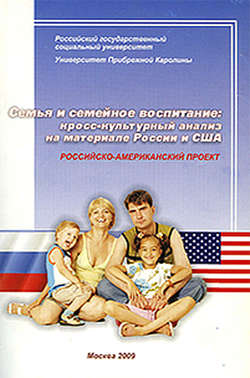Читать книгу Семья и семейное воспитание: кросс-культурный анализ на материале России и США - Коллектив авторов - Страница 36
На сайте Литреса книга снята с продажи.
Американская семья в xxi веке
Литература
Оглавление1. Amato,Р. (2001). Children of divorce in the 1990s: An update of the Amato and Keith (1991) meta-analysis. Journal of Family Psychology, 15, pp. 355–370.
2. Amato, P. (1996), Explaining the intergenerational transmission of divorce. Journal of Marriage and the Family, 58 (pp. 628–640).
3. Bellah, R., Madsen, R., Sullivan, W, Sw idler, A., & Tipton, S. (1985). Habits of the heart: Individualism and commitment in America. Berkeley: University of California Press.
4. Berk, L. (2005). Infants, children, and adolescents (5th ed.). Boston: Allyn and Bacon.
5. Bramlett, M., & Mosher, W. (2002). Cohabitation, marriage, divorce, and remarriage in the United States.
6. Bumpass, L., Sweet, J., & Martin, T (1990). Changing patterns of remarriage. Journal of Marriage and Family, 52, pp. 747–756.
7. Casper L., & Bianchi, S. (2007). Cohabitation. In A. Skolnick & J. Skolnick (Eds.), Family in transition (14th ed.). Boston: Allyn & Bacon.
8. Cherlin, A. (1992). Marriage, divorce, remarriage. Cambridge, MA: Harvard University Press.
9. Cherlin, A. (2008). Public and private families: An introduction (5th ed.). Boston: McGraw Hill.
10. Coleman, M., Ganong, L., & Fine, M. (2000). Reinvestigating remarriage: Another decade of progress. Journal of Marriage and Family, 62, pp. 1288–1307.
11. Giele, J. (2007). Decline of the family: Conservative, liberal, and feminist views. In A. Skolnick & J. Skolnick (Eds.), Family in transition (14th ed.). Boston: Allyn & Bacon.
12. Glendon, M. (1987). Abortion and divorce in Western law. Cambridge, MA: Harvard University Press.
13. Goode, W (2007). The theoretical importance of the family. In A. Skolnick & J. Skolnick (Eds.), Family in transition (14th ed.), Boston: Allyn & Bacon.
14. Hackstaff, K. (2007). Divorce culture: A quest for relational equality in marriage. In A. Skolnick & J. Skolnick (Eds.), Family in transition (14th ed.). Boston: Allyn & Bacon.
15. Hernandez, D. (2007). Changes in demographics of families over the course of American history. In A. Skolnick & J. Skolnick (Eds.), Family in transition (14th ed.). Boston: Allyn & Bacon.
16. Hetherington, E., & Clingempeel, G. (1992). Coping with marital transition. Monographs of the Society for Research in Child Development, 57.
17. Huurree, I, Junkkari, H., & Aro, H. (2006). Long-term psychological effects of parental divorce: A follow-up study from adolescence to adult. European Archives of Psychiatry and Clinical Neuroscience, 256, pp. 256–263.
18. Lehrer, E., & Chiswick, C. (1993). Religion as a determinant of marital stability. Demography, 30, pp. 385–404.
19. McLoyd, V, Aikens, K, & Burton, L. (2006). Childhood poverty, policy and practice. In W. Damon & R. Lemer (Eds.), Handbook of child psychology (6th ed.). New York: Wiley.
20. Oppenheimer, V. (1994). Women’s rising employment and the future of the family in industrial societies. Population and Developmental Review, 20, pp. 203–342.
21. Phillips, R. (1991). Untying the knot: A short history of divorce. Cambridge, England: Cambridge University Press.
22. Raley, R., & Bumpass, I. (2003). The topography of the divorce plateau: Levels and trends in union stability in the United States after 1980. Demographic Research, 8, pp. 245–259.
23. Rodgers, J., Nakonezny, R, & Shull, R. (1999). Did no-fault divorce legislation matter? Definitely yes and sometimes no. Journal of Marriage and the Family, 61, pp. 803–809.
24. Santrock, J. (2008). Educational psychology. (3rd.). Boston: McGraw Hill.
25. Skolnick, A., & Skolnick, J. (2007). Family in transition (14th ed.). Boston: Allyn and Bacon.
26. Sedlak, A., & Broadhurst, D. (1996). Executive summary of the third national incidence study of child abuse and neglect. Washington, DC: National Center on Child Abuse and Neglect, Administration for Children and Families, U.S. Department of Health and Human Services.
27. Smith, J., & Ward, M. (1985). Time-series growth in the female labor force. Journal of Labor Economics, 3, pp. 859–890.
28. Smock, R, & Gupta, S. (2002). Cohabitation in contemporary North America. In A. Booth & A.C. Crouter (Eds.), Just living together: Implications for cohabitation on families, children, and social policy (pp. 53–84). Mahwah, NJ: Earlbaum.
29. Sorenson, S., Upchurch, D., & Shen, H. (1996). Violence and injury in marital arguments: Risk patterns and gender differences. American Journal of Public Health, 86, pp. 35–40.
30. Steinmetz, S. (1987). Family violence: past, present, and future. In M.B. Sussman & S. K. Steinmetz (Eds.), Handbook of marriage and the family. New York: Plenum Press.
31. Stets, J., & Straus, M. (1989). The marriage as a hitting license: A comparison of assault in dating, cohabiting and married couples. In M.A. Pirog-Good & J.E. Stets (Eds.), Violence in dating relationships. New York: Praeger.
32. Straus, M., & Stewart, J. (1999). Corporal punishment by American parents. Clinical child and Family Psychology Review, 2, pp. 55–70.
33. Thome, B. (1992). Feminist rethinking of the family: An overview. In B. Thome & M. Yalom (Eds.), Rethinking the family: Some feminist questions, rev. ed. Boston, MA: Northeastern University Press.
34. U.S Bureau of Justice Statistics. (1995). Violence against women: Estimates from the redesigned survey (NCJ 154348). Washington, DC: U.S. Government Printing Office;.
35. U.S. Department of Health and Human Services. (2003). Child maltreatment 2001. http://w\v\v.acf.hhs.gov.
36. U.S. National Center for Health Statistic s. (19 91). Advance report of final marriage statistics* 1988 (Monthly Vital Statistics Report, 40, No. 4 Supplement). Washington, DC: U.S. Government Printing Office.
37. U. S. National Institute of Justice. (2006). Extent, nature, and consequences of rape victimization: Findings from the national violence against women survey. http 7/www. nci rs. gov.
38. U. S. National Institute of Justice. (2000). Extent, nature and consequences of intimate partner violence (No. NCJ 181867).
39. Wällerstem, J, & В lakes lee, S. (1989). Second chances: Men, women and children in a decade after divorce. New York: Ticknor and Fields.
40. И allerstein, J., Lewis> J& В lakes lee, S. (2000). The unexpected legacy of divorce. New York: Hyperion.
Перевод с английского А.Ю. Васильевой
